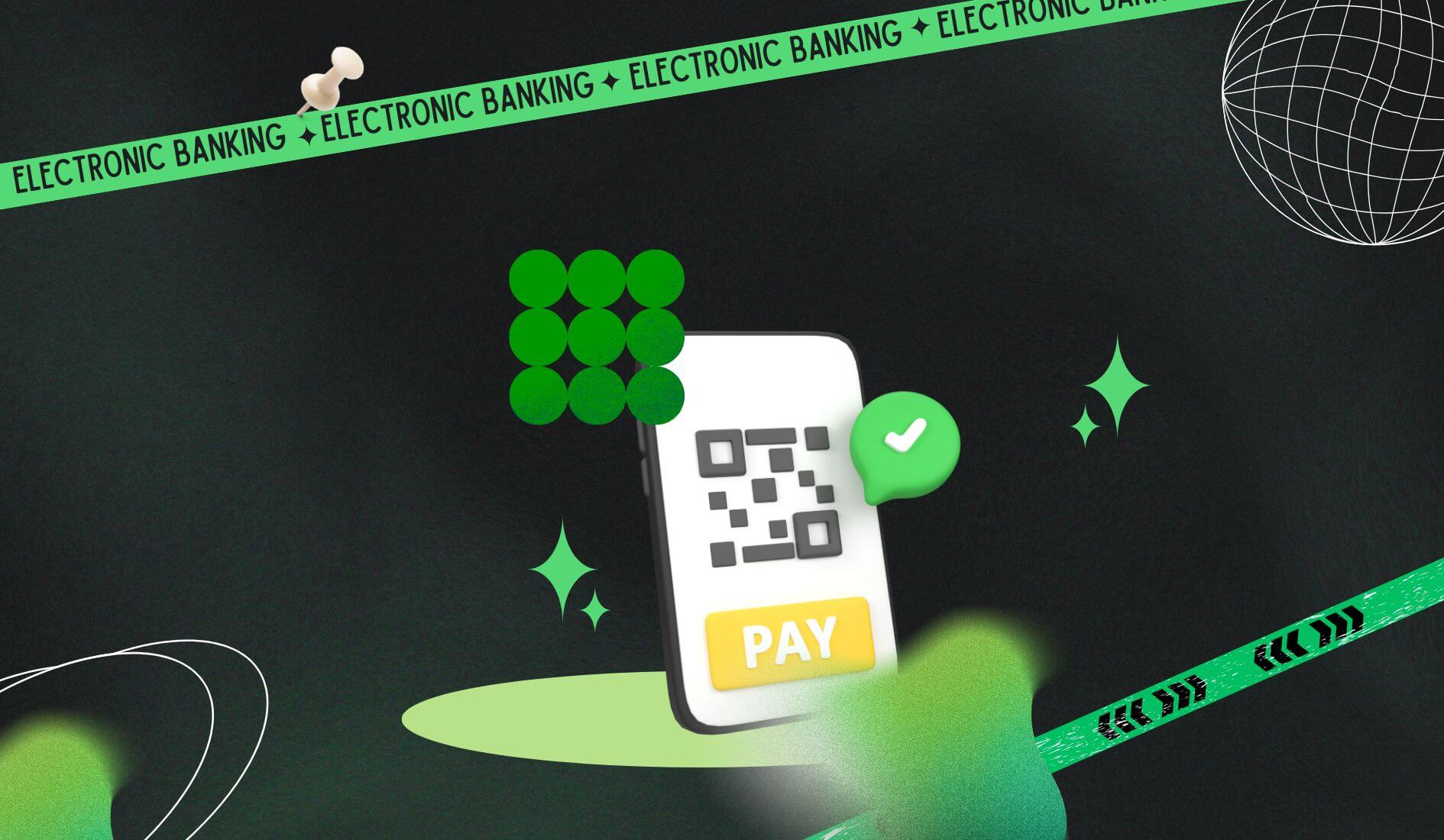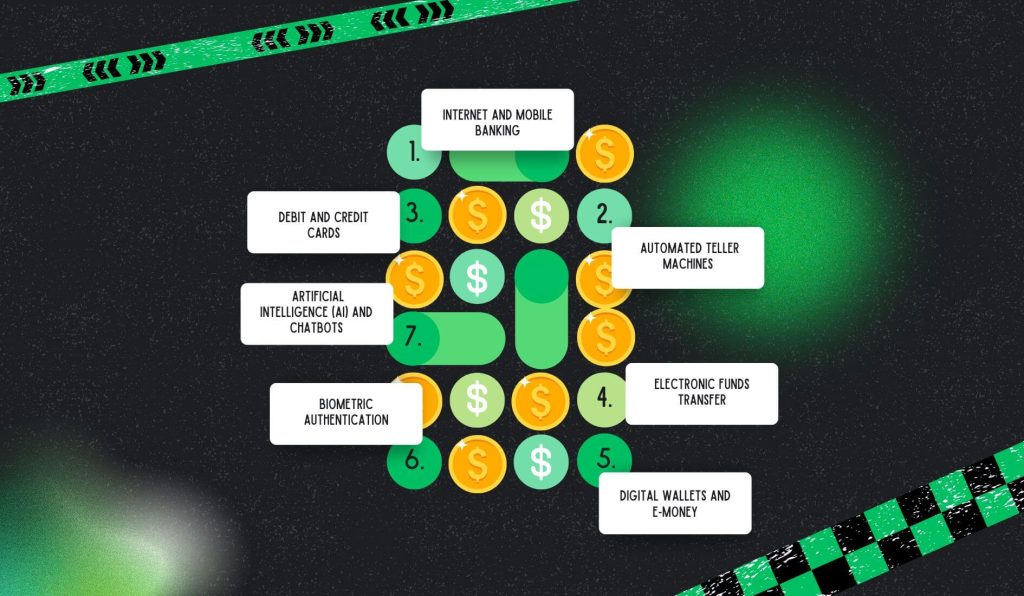- Major Types of Electronic Banking Services
- 1. Internet and Mobile Banking
- 2. Automated Teller Machines (ATMs)
- 3. Debit and Credit Cards
- 4. Electronic Funds Transfer (EFT)
- 5. Digital Wallets and E-Money
- 6. Biometric Authentication
- 7. Artificial Intelligence (AI) and Chatbots
- Electronic Banking Is the Future!
- Frequently Asked Questions (FAQs) on Electronic Banking
Types of Electronic Banking Services You Should Know

Electronic Banking is not merely a buzzword anymore. It is how most Americans move money, pay bills, and check balances without stepping into a bank.
LiveBank’s 2024 report says that more than 73% of U.S. adults indulge in some form of digital banking service at least once a week. Britannica defines electronic banking as using electronic means to conduct banking activities. That is pretty much the reality now.
Hence, whether you are a small business owner or merely someone trying to avoid ATM queues, knowing what is out there helps. Now, it is not just about convenience, but about control, speed, and security.
Major Types of Electronic Banking Services

The following are the major types of electronic banking services that you must know:
1. Internet and Mobile Banking
Internet banking is what you do on your laptop. Mobile banking is the one that is on your phone. Both let you transfer funds, pay bills, and manage accounts.
However, mobile banking goes further by providing the following features
- Push notifications
- Biometric logins
- QR code payments.
Bank of America is an app, for instance, that lets users lock cards instantly. In this case, you will be able to track spending in real time. Now, mobile banking has overtaken desktop usage in the last five years. That is not surprising, as phones are always within reach.
The biggest win here is 24/7 access, no matter where you are. Hence, you are not bound by branch hours. Also, you will be able to move money at midnight or check balances during a flight.
In addition to that, encryption and two-factor authentication (2FA) are standard now. Apart from that, banks work with SSL protocols and biometric logins to keep things tight.
Still, users must stay alert. This is because phishing scams are getting smarter. In spite of all these issues, this system is much safer than carrying cash or writing checks.
2. Automated Teller Machines (ATMs)
Primarily, ATMs were cash dispensers. Now, they are mini-branches where you will be able to deposit checks, change your PIN, and even print mini-statements. Apart from that, some machines come with multilingual support and voice-guided navigation.
Presently, ATMs have evolved to include cardless withdrawals through mobile apps. That is a major update for people who forget their wallets (but not their phones).
Also, the best thing about ATMs is that they are everywhere. These include gas stations, malls, airports, and other places. This shows that they are accessible. In addition to that, most ATMs are open 24/7. Moreover, surveillance cameras and anti-skimming tech are standard now.
Apart from that, banks also work with geo-fencing to monitor suspicious activity. Despite that, try to avoid isolated machines at night (Common sense goes a long way).
3. Debit and Credit Cards
While debit cards pull from your account, credit cards borrow from the bank. However, the usage overlaps. This is because both the debit and the credit card work online and offline. Also, you will be able to tap, swipe, or enter details manually.
In general, credit cards are more secure, especially for online purchases. That is why many people prefer them for big-ticket items.
The following are some of the major benefits and security of having a debit/credit card:
- Rewards programs
- Cashback
- Travel points (credit cards come loaded).
- Debit cards are less flashy and are safer for budgeting.
- EMV chips and tokenization make both secure.
Meanwhile, tokenization (replacing card details with random codes) has cut fraud rates significantly. Despite that, make sure to monitor statements regularly. This is because fraud detection systems are not perfect.
4. Electronic Funds Transfer (EFT)
EFT is the backbone of digital banking. It is how money moves electronically. Moreover, NEFT, RTGS, and IMPS each have their own speed and cost.
- NEFT is good for scheduled payments.
- RTGS is for high-value and real-time transfers.
- IMPS is good for instant payments (even on weekends).
Essentially, speed is the big draw in those situations. You do not wait days for checks to clear. Apart from that, cost-effectiveness is also important. For instance, most EFTs are free or low-cost.
Meanwhile, encryption and authentication protocols keep things secure. Also, banks work with layered security (from OTPs to device fingerprinting). However, you must double-check recipient details. This is because one wrong digit will send money to the wrong account.
5. Digital Wallets and E-Money
Some major examples of digital wallets are Apple Pay, Google Wallet, and PayPal. E-money is the stored value inside them. All you have to do is tap into your phone to pay, send money to friends, or buy online.
Now, these wallets integrate loyalty programs and come with real-time spending insights. In fact, many consider it “banking without the bank.”
Convenience is unmatched when it comes to digital wallets and E-money. Hence, you do not have to carry cards. All you need is your phone. Moreover, biometric authentication (fingerprint and face ID) adds a layer of security.
In addition to that, tokenization ensures your card details are secured. Still, make sure to enable remote wipe features. If your phone is lost, your wallet should not be.
6. Biometric Authentication
Biometric authentication uses your body (fingerprint, face, and voice) to verify identity. This way, it is replacing passwords. In fact, banks utilize it for logins, transactions, and even ATM access. Interestingly, fingerprint recognition is the most common, followed by facial and voice recognition.
The best thing about biometric authentication is that security is tighter since biometrics are hard to fake. Also, it comes with more convenience. Hence, no need to remember passwords. Moreover, banks are integrating these features into apps and ATMs. Some even work with behavioral biometrics (like how you type or swipe).
Still, there are many privacy concerns. Hence, before you start using, read the fine print before opting in.
7. Artificial Intelligence (AI) and Chatbots
Obviously, AI is reshaping banking with its capability of curation and analysis. Meanwhile, chatbots handle queries, recommend products, and even flag suspicious activity.
Deloitte reports that more than 60% of U.S. banks choose AI-powered chatbots for customer service. This is because they are fast, tireless, and available 24/7.
The following are some of the major benefits of AI and chatbots in banking:
- More efficiency.
- No wait times.
- Personalized service.
- AI learns your habits and tailors suggestions.
However, there is a flip side. For instance, data privacy is a concern. Also, bots can misinterpret queries. Hence, human oversight is still necessary. Moreover, banks are working on hybrid models.
Electronic Banking Is the Future!
Electronic Banking is not a mere convenience but a necessity. In fact, the landscape is fast changing with the introduction of mobile apps, biometric logins, and more. Hence, it is important to stay informed. This will help you with ease of usage as well as safety.
Finally, the future is all about open banking, blockchain, and smart AI. But for now, try to get a better idea of the basics (Internet banking, ATMs, EFTs). Also, explore the options and choose what fits best.
Frequently Asked Questions (FAQs) on Electronic Banking
Electronic banking involves using digital platforms and technologies to perform banking activities. These include fund transfers, bill payments, and account management. The best part is that you don’t have to visit a physical branch.
EFT moves money electronically between accounts. Some of these systems are NEFT, RTGS, and IMPS. In this case, each comes with different speeds and costs.
Primarily, AI comes with the following benefits for banking:
• Enhances customer service through chatbots
• Fraud detection
• Personalized financial recommendations.
• Improves efficiency (but requires careful data handling).










